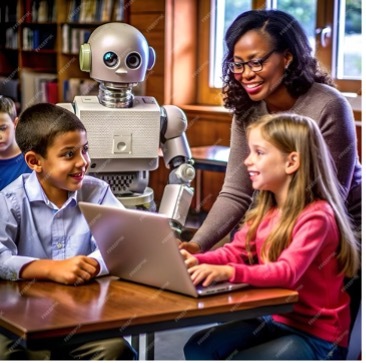AI and Education: Enemy or Partner?

AI isn’t going anywhere. That means educators and their students must figure out how to use AI responsibly and effectively. Many believe that it has the potential to make education more individualized and equitable.
The U.S. Department of Education’s Office of Educational Technology (OET) released new guidelines for EdTech companies earlier this year called “Designing for Education with Artificial Intelligence.” “The report underscores the need for ‘responsible innovation,’ adding, ‘educator and student feedback should be incorporated into all aspects of product development, testing, and refinement to ensure student needs are fully addressed.’ (www.the74million.org) Dan Fitzpatrick is right: “The message is clear for developers. Innovate responsibly or risk irrelevance… In a world increasingly defined by AI, creating truly intelligent and ethical AI for education isn’t just an opportunity. It’s a responsibility.” (www.forbes.com)
XQ, the group rethinking high school, reminds us that AI tools are not just for educators: “they also exist to improve students’ learning. Rather than focusing exclusively on improving output (such as lesson plans and assessment materials), makers should also emphasize improving outcomes, such as student proficiency and engagement.” (www.the74million.org) Ann-Katherine Kimble, XQ’s Director of School Success, said that students “deserve a point of view that believes that AI can enhance your practice and knowledge, deepen your creative and responsive approaches and help educators capitalize on the sweet spot where the art of teaching and the science of learning meet.” (Ibid.)
What does that look like in real life? One example comes from students in a high school in Memphis, Tennessee. They “explored how to build AI applications to track hand movements for American Sign Language, highlighting the value of learning how AI works, writing code in Python and experimenting with tools like Google’s MediaPipe.” Their teacher insists that concerns about teaching are overblown, since AI never sounds like a high school student. (Ibid.)
Teachers like Tim Brodsky, “recognized by the U. S. Department of Education for his innovative use of generative AI to support multilingual learners in his AP courses, developed a system of real-time automated feedback. Brodsky can analyze data and get insights into his students’ needs this way. (Ibid.)
When AI developers and educators work together, they can ensure tools that work both technically and pedagogically. For example, Nikki Wallace, an educator at Crosstown High in Memphis, had students looking at statistics for infectious diseases that impact Memphis. Their chatbot helped them progress through the science project by unpacking and generating complex questions such as “What community partners in Memphis can I reach out to?” and “What information in the research might I have overlooked?” and “What governmental systems are in place?” (Ibid.)
AI is no doubt going to proliferate in schools. The challenge for educators is how to make its expansion support learning. We know that AI can help produce customized lessons for students at a rate that isn’t realistic for teachers. It can adapt lessons not only for students who are struggling but also for those who would benefit from more challenging work, and it can provide real-time feedback to individuals at a rate beyond what’s possible for a teacher with a room full of students.
AI might also be used to develop “intelligent textbooks,” using an iPad app with interactive text that can “suggest questions about the content and areas for future inquiry that are
customized for each individual… [and]can change the reading level of the text and also include
supplemental photos, videos and materials to help students understand what they’re studying.” (theconversation.com)
AI can also improve assessment because it can adjust the difficulty level of questions by identifying patterns. I am in my third month of using Duolingo to resurrect my Italian, and I’m fascinated by how this app incorporates review of my errors and adjusts instruction based on my progress. Students should have that opportunity. And AI can personalize learning: “an AI-powered recommender system can generate tailored assessment questions, detect misunderstandings and suggest new areas for a learner to explore.” (Ibid.)
I remember when the internet became a real part of our school. Librarians taught students how to evaluate websites and use them widely. We can educate librarians to become leaders in verifying information in the age of AI. They – or teachers – can teach students to research the author or organization, using tools like the P.R.O.V.E.N. Source Evaluation method, which recommends that readers check the author’s credentials and affiliations, consider the authors’ advanced degrees or expertise related to the topic, explore other work have they written, question who funds the organization and their affiliations? Do any of these affiliations reveal a potential conflict or bias for one particular viewpoint? (www.wqow.com) These are the kinds of questions used to evaluate websites before, but they are even more important now.
Librarians and teachers can challenge students to use good search techniques, like using two words together in quotation marks like “Mars landing,” searching keywords rather than full sentences, and limiting searches by domain names, such as .org, .gov, or .edu. Students should verify the original source of the information and check original studies when possible. This is especially important for news stories that my misrepresent or misquote the original sources.
Staff should teach students to use fact-checking websites like InfluenceWatch.org, Poynter.org, Politifact.com, or Snopes.com to verify claims. A Harvard Kennedy School Misinformation Review article found that the “high level of agreement” between fact-checking sites “enhances the credibility of fact checkers in the eyes of the public.” Students should also pause and reflect about the impact of a piece: we know that writing that triggers a strong emotional response increases our tendency to believe fake news, so a thoughtful approach and investigation can make a difference.
It is far too tempting for school districts to play ostrich and wish for AI to disappear. It won’t. Responsible educators will figure out how to harness this tool for good and limit its damage. It may seem like a daunting task, but we must rise to the occasion or we will fail our students and our nation.



